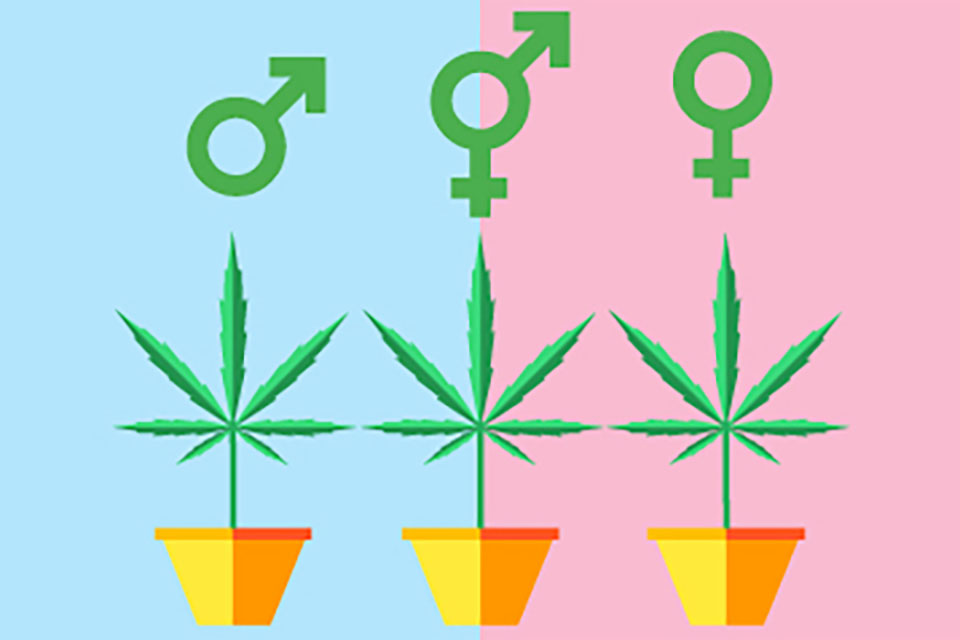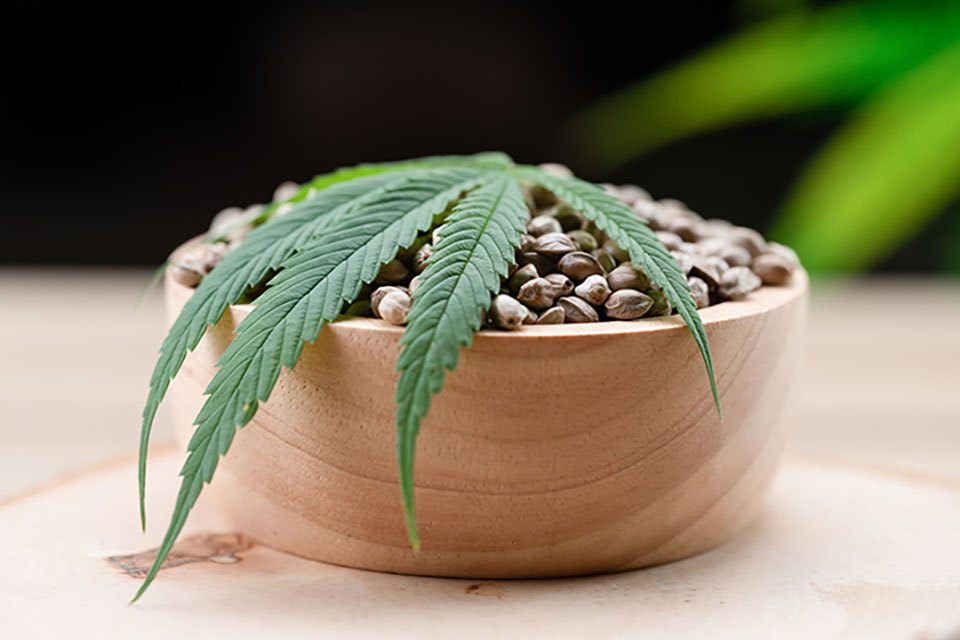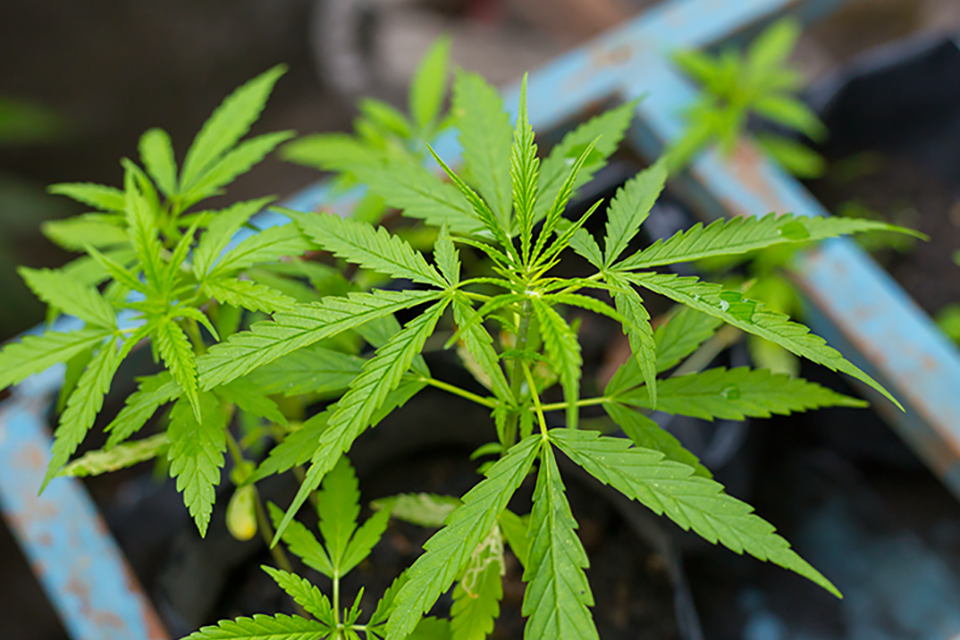
What You Should Know About Gender in Cannabis Plants
Understanding cannabis plant gender and reproduction is crucial to a successful harvest, but it can be quite confusing. This comprehensive guide will explain the plants reproductive process, hermaphroditism, and what to do with male cannabis plants.
Plant Reproduction
Marijuana plants are dioecious, which means there are two separate genders. Each plant has two pair of chromosomes; male plants have XY, while females have XX. Like humans, there is an almost equal number of females and males.
Cannabis plants can be hermaphroditic, which means that they may have two sets of reproductive organs (pistils and stamens). The plant’s gender depends on its genetics and certain environmental factors. That is why, when cultivating cannabis, it is important to learn the traits of male and female plants.
Gendering Cannabis Plants: Trait Identification
Though it’s crucial to learn the differences between male and female cannabis plants, it’s difficult because a plant’s gender isn’t immediately apparent. Marijuana plants’ gender does not reveal itself until the garden has been on a 12/12 light/darkness cycle for an extended period, but for some growers, waiting that long is impossible.
When male and female plants are grown alongside one another, the male plants pollinate the females. Female plants with no seeds have more THC, while males make much less. Therefore, it is best to determine the plant’s sex as soon as possible. Preventing cross-pollination is the most effective way to ensure high-quality buds. This is also where the appeal comes in for growers to order feminized seeds to remove that guesswork from the growing process.
Female Cannabis Plants
It is fairly easy to recognize female pot plants. While both plant genders form flowers, a female plant’s flowers typically emerge after the males. Female flowers look like sacs with small, feathery growths called stigmas. The sacs gradually open to form tiny white, cream-colored, or yellow flowers with whitish, hairy pistils that grab and hold onto pollen. The stigmas are found on the main plant stalk at points where branches emerge. These sticky resin-covered buds are the most reliable source of good chronic that USA weed consumers are looking for
Male Cannabis Plants
The easiest way to identify male plants is by their rapid maturation. Male plants mature much faster than female plants do, so they can successfully pollinate the female plants. The male plant’s flowering phase may start up to a month before the females, giving the grower plenty of time to identify them. This is true in any US growing environment, whether you grow in Missouri or Maryland.
Male plants typically grow straighter and develop fewer flowers. A male plant’s flowers are usually found near the crown, and unlike the female’s flowers, they look like compact green clusters. Sometimes mistaken for buds, these flowers are really pollen sacs. With time, the clusters open and stamens emerge. Then, the male plants are ready for cross-pollination.
Pre-Flowers
It is difficult to determine a cannabis plant’s gender based on its flowers, simply because there is only a short time between their emergence and pollination. Experienced growers look for pre-flowers, which develop on main stems and branch tips. If there are raised calyxes on stalks and stems, the plant is probably a male. If the calyxes are not raised, the plant is likely female.
Determining Plant Gender
Sometimes, a grower just cannot wait for characteristics to emerge. Here are some other ways to identify the gender of your weed plants.
- Look at the plant’s growth patterns: During the vegetative stage, all plants, regardless of gender, start to flourish. As they age, however, subtle size differences start to emerge. Female plants often develop more complex branches when moving into the vegetative stage, while males are slightly taller and not as bushy. This method is most effective on outdoor plants in Hawaii or Texas, as those in indoor grow rooms may exhibit fewer of these tendencies.
- Identify the sprouting location: When it is important to know a plant’s gender right away, this method may work. Some growers say that, if the sprout emerges at the top or the bottom of a seed, the plant is female. If the sprout comes out on the side, it will turn out to be a male plant. Though this method has not been proven by science, growers who use it report success rates approaching 90%.
- Plant cloning: This is the only foolproof way to gender plants before maturity. It is easy to do, and all you will need is a cutting from a healthy plant. Put the cutting into some soil, let it grow, and bring it into the flowering stage with a 12/12 light/darkness cycle.
Cannabis Plant Flowering and Reproduction
Once you have separated the plants by gender, they are ready for reproduction. On a female plant, large buds emerge. These clusters, called colas, are made of hundreds of sub-units. The pistils, which lie within the colas, control the plant’s reproductive process through their interactions with pollen. Once a plant has matured, it is time to harvest the buds and enjoy the fruits of your labor.
Pollination
When male cannabis plants mature, they release pollen to be taken in by the female plants’ stigmas. From there, the pollen moves to the egg cells inside the pistils, producing seeds. If the seed creation process does not occur, the female plant’s flowers start to change.
The pollen from male plants may live for several days as it seeks female plants. Pollen may live in air ducts and on fabrics, and many growers store it for fertilization purposes. Pistils enlarge when they are not fertilized, so they are more likely to find pollen.
The effects are not very long-lasting. When the female plant’s pistils are fully mature, the stigmas die, and they cannot be fertilized. At that time, resin production slows or stops, and the plant’s trichomes degrade. Pistil maturation is a slow process, giving a grower enough time to harvest the crop.
Auto-Flowering Plants and Seeds
Standard cannabis plants typically begin to flower at summer’s end, as the days get shorter and there is less natural light. However, auto-flowering plants are a bit different; they enter the flowering phase even if they are under the lights for 24 hours. Auto-flowering seeds and plants are useful in places with odd growing seasons, or when a grower wants two crops per season. Feminized seeds offer another important benefit, in that there is no need to separate plants by gender.
Using Male Plants
It is an exciting time in the grow room when a plant’s gender becomes known. If there is a male plant in the middle of the garden, you may not know what to do. Some believe there is no need to keep male plants; after all, they do not make the big, dank buds everyone wants. However, there are still many uses for male plants.
- Hemp fiber: Cannabis plants of both genders are used in the creation of hemp fiber. The fiber from male plants is much softer and it is best used in textiles. Female plants’ fiber is better for rope.
- Breeding: If you are breeding plants, males are a must. Even the most successful cloning program gets boring, and males are useful if their genes are good.
- Hash: Male marijuana plants do contain THC, but in much lower quantities than in female plants. Though male plants do not yield the buds most growers want, they can be used to make concentrates such as hash. Leaves, trimmings, stems, and other parts still contain THC, which should not be wasted.
- Protecting the garden: Male plants can be used to protect the entire crop. They contain terpenes, which naturally prevent disease and control pests.
Male plants are a crucial component in various cultivation programs. When in doubt, do not throw it out; use it in any way possible!
Hermaphrodite Marijuana Plants
Cannabis plants, like all others, go to great lengths to reproduce. In some cases, these plants even switch genders to make it possible! This evolutionary ability protects the species and ensures genetic diversity. Hermaphroditic plants exhibit female and male characteristics, and many times, they change due to stress.
Although the change is perplexing to growers, these plants do have a purpose. Cannabis plants are somewhat gender-fluid, even though they produce female and male flowers separately. By controlling lighting, temperature, soil pH, nutrition, and other factors, you’re less likely to end up with a hermaphroditic plant. When breeding, choose mother plants that show no signs of the condition.
To know what to do with these plants, it is important to identify them as soon as possible. Because they exhibit male and female reproductive features, they can quickly pollinate themselves and put the entire crop at risk. When these plants are found within your backyard Rhode Island garden, they should be culled (removed) as soon as possible.
When growing cannabis for recreational or medicinal use, it is not necessary to go to extreme lengths to save the plants. Whether you’ve ended up with a few males or a hermaphrodite, sometimes it’s best to absorb the loss, remove the plant, and focus on the rest of the crop. After all, if you are spending enough time on the good parts of the garden, the yield will certainly be optimal.
Cannabis plant reproduction is a complex process, especially when the plants pollinate themselves under some conditions. Cultivation requires a certain degree of diligence, and if you know how to determine the plants’ gender early on, you are more likely to end up with a bumper crop. With quality American seeds from kindseed.com, it is easy to get started.


